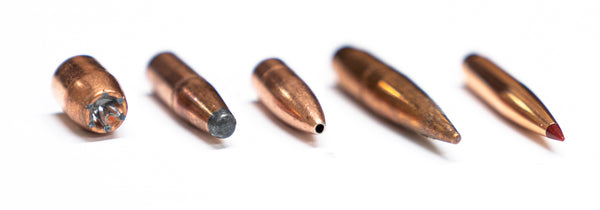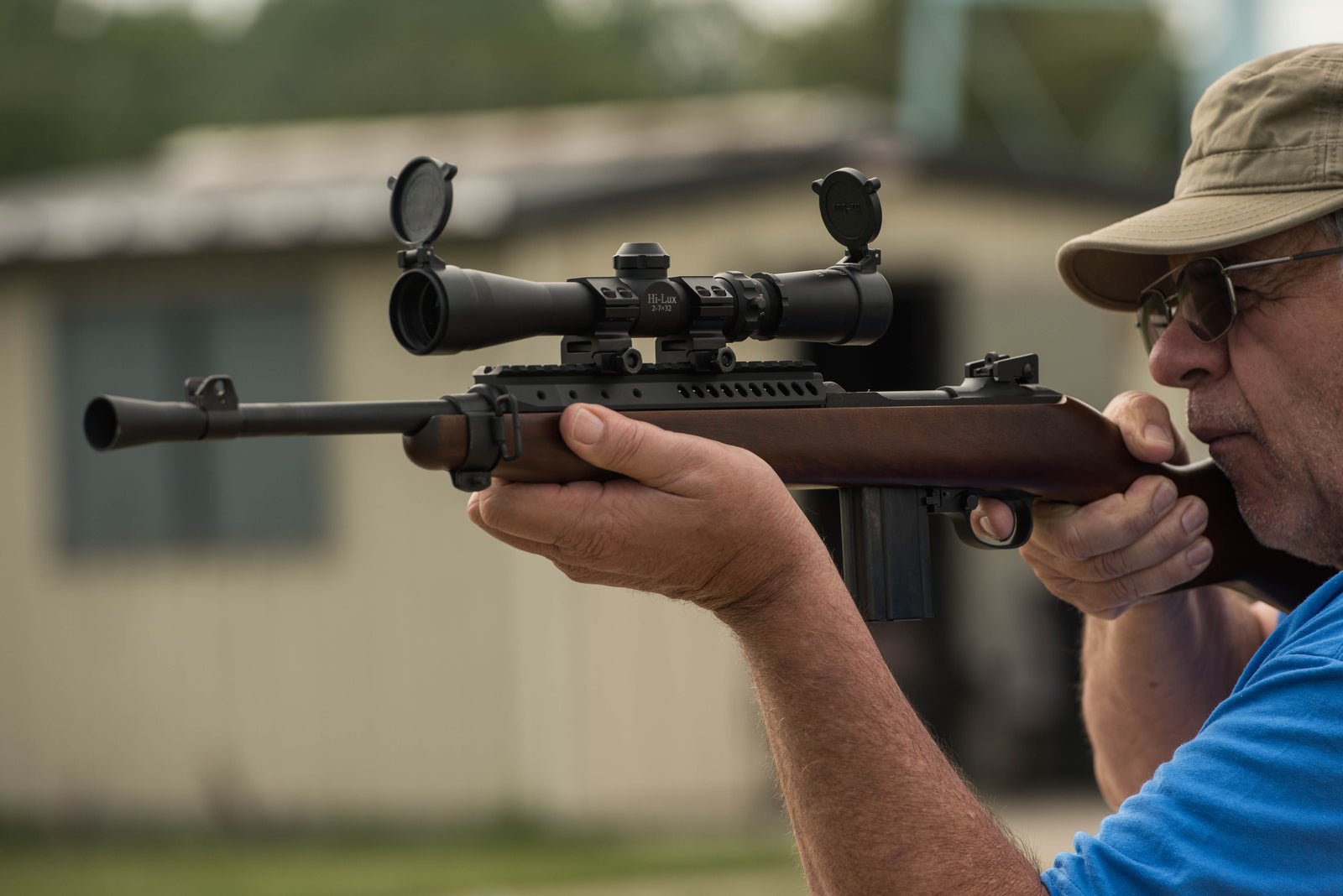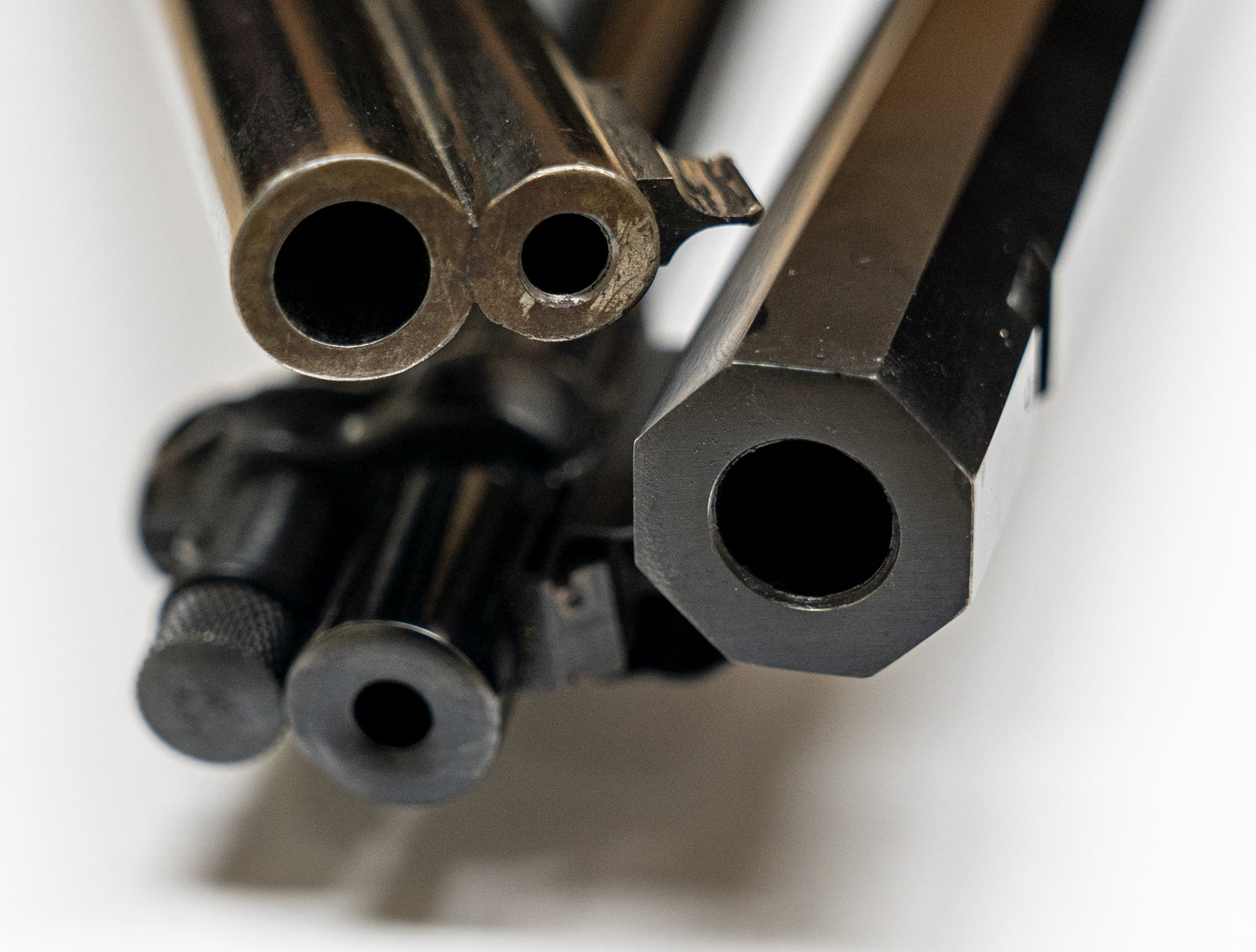The bullet is the chunk of metal that actually exits the rifle’s muzzle, provided everything works the way it should. Ideally, it’ll be going at a tremendous speed with a good amount of spin. Think of the bullet as a high-speed football.

A bullet with many parts labeled. They’ll be detailed below.
Let’s start, of course, with more vocabulary.
The nose is the front tip of the bullet, where it’s narrowest. This is the tip that will hit the target. There are many types of noses - all varieties of roundness and pointiness, which serve to provide certain characteristics. A bullet’s aerodynamic qualities become more important as it is sent out to further distances. For a full-power rifle cartridge, distances inside of 100 or 200 yards will provide very little time for the bullet to be pushed off course. As the bullet travels farther and farther, air resistance will slow it down, gravity will make it fall faster, and the wind will push it to one side or another. The better your bullet is able to cut through the resistance, the more speed it will retain. If it can reach your target faster, it’ll be pushed less off course by wind and gravity. For this reason, bullets that are built to travel great distances are very aerodynamic - in other words, very pointy.
Contrast this with bullets used in hunting. Most hunting distances are within 200 yards, simply due to trees, hills, and other sight blockers. The bullet will still retain a great deal of kinetic energy and velocity when it meets a target inside this distance. Instead of pointiness, hunting rounds are designed with tips that hit the target and dump all the energy into that hit. These noses are often round and made of soft lead. Sometimes, they’re built to open up upon hitting something hard. In some unusual bullets, the nose is completely flat.

For your consideration, a few bullets. The largest is meant to travel a long range with a great deal of kinetic energy. The second is a close-range hunting bullet, from the popular .30-30 Winchester round. The smallest is a fairly normal bullet from a 9mm Luger round, meant only for close range.
The material of the nose matters on impact. While the bullet is racing towards the target, however, only the nose’s shape is important. Some rounds are built with a plastic tip, meant to provide an aerodynamic shape to the bullet in flight. Underneath this plastic tip, the bullet may have a small hollow cut into the tip of the nose. If designed well, the plastic tip can push into the hollow on impact and start the expansion quickly. A broad hollow point with no plastic tip, as you may see in some pistol cartridges, has pretty poor aerodynamic abilities and great expansion on impact. Lastly, and certainly not the least, are bullets with a small hollow at the tip, meant to actually improve ballistic performance without a fine point.
There are certainly many styles of noses. Choosing the right nose will be a balance of material and shape. Generally, longer distances require pointier bullets - regardless of material.

A variety of bullets, in order of aerodynamic efficiency. On the left, a hollow point meant for close range. At the far right, a soft tipped bullet for great long-range shooting.
Even if your bullet is built with a very sharp tip, it won’t be a perfect knife-sharp point. The tip will be a tiny bit flat. If there’s a small hollow point at the tip, the narrow rim around the circumference of the hollow will also be flat. This flat area of the nose is known as the meplat. Sometimes, you might notice that the meplat is at an angle or cut roughly. At close ranges, an uneven meplat will have little effect on your ballistic arc. At very long distances, the meplat becomes yet another factor that can affect your precision. Curiously, many bullets used in long range shooting will have a very small hollow point - barely enough to fit a needle into. This tiny hollow point gathers air during the flight, creating an air pocket that perfects the geometric shape of the bullet. The tiny hollow point can actually increase the aerodynamic capabilities of your bullet.

The ogive is the curved exterior section that leads up to the nose. The specific curve of this region of the bullet is often a point of contention, and has a great deal of effect on the overall aerodynamic drag on the bullet. Specifically, a longer ogive generates less drag on most occasions. A short ogive, meaning the nose is very blunt, undergoes more drag as it cuts through the air. Another way to think of this - a rocket is long and pointy at the tip. It has a long ogive, and is very good at going fast in one direction. A baseball is round and stumpy by comparison. Baseballs have a short ogive, and the potential to be a wobbly knuckleball. For long-range precision shooting, a long ogive is preferred.

A look at the ogives on a few common bullet shapes. The bullet at the left is built for the longest range of the three, and has a correspondingly long ogive.
The caliber is the maximum diameter of the bullet. The outermost wide portion. This is what runs along the rifling inside the barrel. Specifically, the part touching the rifling is the bearing surface. A longer bearing surface means greater friction as the bullet moves down the barrel. A perfectly round ball, as in old muskets, has the least amount of bearing surface… and also the chance to roll. Modern bullets have a short length at the diameter of the caliber to give the bullet enough bearing surface to both spin and stabilize.
If a bullet has an angled or tapered rear section, that’s known as a boat tail. Boat tails help reduce drag on the bullet, though there's an argument as to how much. Some tests show that a boat tail may reduce drop by as little as 1” at 1000 yards. Every bit of precision counts, so almost all bullets used in long distance shooting will have a boat tail. By comparison, most handgun bullets will not have a boat tail. When you’re shooting at greater distances, every little bit of aerodynamic potential helps. Unfortunately, the boat tail is hidden by the case. To see one in person, you’ll have to find a bullet that is removed from the case.

Two bullets, but only one with a boat tail.





Leave a comment (all fields required)